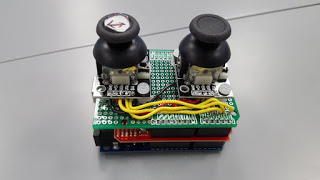Adding Second Joystick to Joystick Shield for Arduino

Added a second joystick to the shield and use one for forward/back motion and the other for turning. I find this setup gives better control.
Jeff Branson, from Sparkfun, saw my project on facebook and suggested I submit it to Sparkfun to be added to their project section. I said I would if I could get some better quality joysticks, like the ones Sparkfun sells :-). I should be receiving those this week and will build up a nicer version and also add some additonal control buttons.
Below is a video of me driving the redbot using the dual joystick conroller.
Code for the redbot
/*****************************************************************
XBee_Remote_Control.ino
*****************************************************************/
#include <RedBot.h> // This line "includes" the RedBot library into your sketch.
// Provides special objects, methods, and functions for the RedBot.
RedBotMotors motors; // Instantiate the motor control object. This only needs
#include "notes.h" // Individual "notes" have been #defined in the notes.h tab to make
// playing sounds easier. noteC4, for example, is defined as 262, the
// frequency for middle C. See the tab above?
RedBotSoftwareSerial XBee; // version of SoftwareSerial that will work with Redbot
const int buzzerPin = 9;
int xval;
int yval;
int swval=1023;
int leftmotorspeed;
int rightmotorspeed;
float temp;
void setup()
{
// Initialize XBee Software Serial port. Make sure the baud
// rate matches your XBee setting (9600 is default).
XBee.begin(9600);
Serial.begin(9600);
pinMode(buzzerPin, OUTPUT);
}
void loop()
{
// if (XBee.available())
if (XBee.available())
{
xval = XBee.read();
yval = XBee.read();
swval = XBee.read();
//xval = Serial.read();
//yval = Serial.read();
//swval = Serial.read();
//normalize the values to a 1 byte value
temp = (float)xval / (float)255;
xval = temp * 1023;
temp = (float)yval / (float)255;
yval = temp * 1023;
temp = (float)swval / (float)255;
swval = temp * 1023;
xval = map(xval, 0, 1023, -255, 255);
yval = map(yval, 0, 1023, -255, 255);
}
if(swval == 0)
{
XBee.end();
// playSmallWorld();
blowhorn();
XBee.begin(9600);
}
if (xval > -40 && xval < 40) // If we are not turning
{
if ((yval < -40) || (yval > 40)) // set motor speed
{
rightmotorspeed = yval;
leftmotorspeed = -yval;
}
else
{
rightmotorspeed = 0;
leftmotorspeed = 0;
}
}
else if (xval>40) // Turning Left, are we moving while turning left or
{ // spinning
if ((yval < -40) || (yval > 40)) // User is moving forward or backwards
{
rightmotorspeed = yval; // drive right motor 100% forward
leftmotorspeed = -yval/2; // runt left by slowing left wheel
}
else // spin
{
rightmotorspeed = 200;
leftmotorspeed = 200;
}
}
else // We are not going straight or turning left, must be right
{
if ((yval < -40) || (yval > 40)) // user is moving forward or backwards
{
leftmotorspeed = -yval;
rightmotorspeed = yval/2;
}
else
{
rightmotorspeed = -200;
leftmotorspeed = -200;
}
}
motors.rightMotor(rightmotorspeed);
motors.leftMotor(leftmotorspeed);
delay(50);
}
void blowhorn()
{
tone(buzzerPin, 1000); // Play a 1kHz tone on the pin number held in
// the variable "buzzerPin".
delay(125); // Wait for 125ms.
noTone(buzzerPin); // Stop playing the tone.
tone(buzzerPin, 2000); // Play a 2kHz tone on the buzzer pin
delay(500); // delay for 1000 ms (1 second)
noTone(buzzerPin); // Stop playing the tone.
}
void playSmallWorld()
{
// we use a custom function below called playNote([note],[duration])
// to play a note and delay a certain # of milliseconds.
//
// Both notes and durations are #defined in notes.h -- WN = whole note,
// HN = half note, QN = quarter note, EN = eighth note, SN = sixteenth note.
//
playNote(noteG5, HN + QN);
playNote(noteG5, QN);
playNote(noteB5, HN);
playNote(noteG5, HN);
playNote(noteA5, HN + QN);
playNote(noteA5, QN);
playNote(noteA5, HN + QN);
playNote(Rest, QN);
playNote(noteA5, HN + QN);
playNote(noteA5, QN);
playNote(noteC6, HN);
playNote(noteA5, HN);
playNote(noteB5, HN + QN);
playNote(noteB5, QN);
playNote(noteB5, HN + QN);
playNote(Rest, QN);
playNote(noteB5, HN + QN);
playNote(noteB5, QN);
playNote(noteD6, HN);
playNote(noteB5, HN);
playNote(noteC6, HN + QN);
playNote(noteC6, QN);
playNote(noteC6, HN);
playNote(noteB5, QN);
playNote(noteA5, QN);
playNote(noteD5, WN);
playNote(noteFs5, WN);
playNote(noteG5, WN);
}
void playNote(int note, int duration)
// This custom function takes two parameters, note and duration to make playing songs easier.
// Each of the notes have been #defined in the notes.h file. The notes are broken down by
// octave and sharp (s) / flat (b).
{
tone(buzzerPin, note, duration);
delay(duration);
}
Code for the JoyStick Controller
/*****************************************************************
XBee_Remote_Controller.ino
*****************************************************************/
// SoftwareSerial is used to communicate with the XBee
#include <SoftwareSerial.h>
// XBee's DOUT (TX) is connected to pin 2 (Arduino's Software RX)
// XBee's DIN (RX) is connected to pin 3 (Arduino's Software TX)
SoftwareSerial XBee(2, 3); // RX, TX
//values read from joy stick i.e. (0-1023)
int xval = 0;
int yval = 0;
int swval = 0;
int xval2 = 0;
int yval2 = 0;
int swval2 = 0;
float temp;
const int xpin = A1;
const int ypin = A2;
const int swpin = A0; // this is the
const int xpin2 = A4;
const int ypin2 = A5;
const int swpin2 = A3;
void setup()
{
// Initialize XBee Software Serial port. Make sure the baud
// rate matches your XBee setting (9600 is default).
XBee.begin(9600);
Serial.begin(9600);
// enable pull up on analog pins that are connected to the SEL output
// of the joystick
//digitalWrite(A0, HIGH);
//digitalWrite(A3, HIGH);
}
void loop()
{
xval = analogRead(xpin);
temp = (float)xval / (float)1023;
xval = 255 * temp;
swval = analogRead(swpin); // only concered if swval is 0
if (swval != 0) swval = 255;
yval2 = analogRead(ypin2);
temp = (float)yval2 / (float)1023;
yval2 = 255 * temp;
swval2 = analogRead(swpin2);
if (swval2 != 0) swval2 = 255;
XBee.write(xval); // This first code will be interpreted for steering
XBee.write(yval2); // motor drive
XBee.write(swval);
Serial.print("swval = ");
Serial.println(swval);
delay(50);
if (swval == 0) delay(600); // horn was pressed, give user time to release'
}
David Riewe
Published
Mon 28 December 2015
Comments
comments powered by Disqus